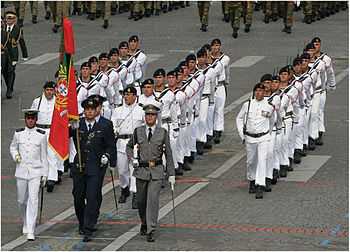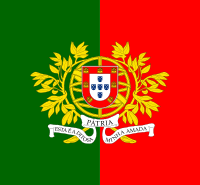Portuguese Marine Corps
| Portuguese Marine Corps Corpo de Fuzileiros | |
|---|---|
|
Coat of arms of the Portuguese Marine Corps. | |
| Founded | 1618 |
| Country |
|
| Branch | Navy |
| Type | Marines |
| Role | Amphibious warfare |
| Garrison/HQ | Lisbon Naval Base |
| Nickname | Fuzos |
| Motto | Braço às armas feito (Arm made to weapons). |

The Portuguese Marine Corps (Portuguese: Corpo de Fuzileiros, meaning literally "Corps of Fusiliers") is the special operations force of the Portuguese Navy. The Corps is specialised in amphibious warfare, coastal reconnaissance, unconventional warfare, guerrilla warfare, raids, maritime interdiction and boarding operations. It is an elite light infantry force, operating as a rapid-reaction force.
Initial Training
Portuguese Marines(Fuzileiros)are required to undergo one of the longest and most physically demanding specialist infantry training regimes in the world. Initial training to become an enlisted fuzileiro (marine) lasts about 42 weeks. The initial training is conducted at the Escola de Fuzileiros in Vale de Zebro. The training is - physically and mentally - both rigorous and demanding. Eventually 15% to 35% of the initial trainees will pass to become Fuzileiros. If successfully completed, the recruits receive their Dark Blue Beret, and are assigned to operational units. The Fuzileiros in training are constantly under stress and pressure from instructors leaving them no respite. All activities are timed and scored: marching several tens of kilometers with equipment and weapon, obstacle course, navigation at night on the ground. The training is punctuated by firearms training and special combat techniques, rappelling and climbing, boating, explosives and hand-to-hand combat.
Organization
The Marine Corps is made up of an administrative command - Comando do Corpo de Fuzileiros (Marine Corps Command); an instruction unit - Escola de Fuzileiros (Marines School); and a base unit - Base de Fuzileiros (Marines Base). The operational units of the Marines, stationed at the Marines Base, are:
- 1st Marine Battalion;
- 2nd Marine Battalion;
- Naval Police Unit;
- Special Actions Detachment;
- Fire Support Company;
- Tactical Transports Support Company.
Based at the Marines School is the Unidade de Meios de Desembarque (Landing Assets Unit).
When needed, several elements of the operational units can organize themselves into a task-force for amphibious assaults called Batalhão Ligeiro de Desembarque (Landing Light Battalion).
History
The Portuguese Marines (Portuguese: Fuzileiros) have their direct origin in the oldest permanent military unit of Portugal, the Terço of the Navy of the Crown of Portugal, created in 1618. However, since 1585, specialized troops existed to provide artillery and riflemen in the Portuguese warships. The Terço of the Navy was soon considered an elite unit, also being responsible for the bodyguard of the King of Portugal.
In the beginning of the 18th century, the force was reorganized, being organized in two regiments: The 1st and the 2nd Regiments of the Navy. Later a Regiment of Naval Artillery was added.
At the end of the 18th century, in the reign of Queen Maria I, all the regiments of the navy were integrated into the new Royal Brigade of the Navy, which included three divisions: Fusiliers (fuzileiros), Artillerymen and Ballasters. In 1808, when Napoleon's army attacked Portugal, the Portuguese Royal Family relocated themselves to the Portuguese colony of Brazil, accompanied by the majority of the Royal Brigade of the Navy. This resulted in the forming of the Brazilian Marine Corps.
In middle of the 19th century, the personnel of the Portuguese Navy underwent militarization. Up to then, the sailors were not militarized, only the officers and the members of the Royal Brigade. With this militarization it was determined to maintain a permanent unit of naval infantry, extinguishing the Royal Brigade. From this date, the forces of naval infantry were organized with the military sailors (they started to receive training from infantry), removed from the crews of ships, and used whenever the necessity existed to carry out amphibious operations. Thus, some battalions and forces of the Navy were organized to participate in the diverse colonial campaigns of the 19th and 20th centuries, as well as in World War I.

In 1924 the Brigade of the Naval Guard was created as a permanent naval infantry unit. However it ceased to exist in 1934.
The naval infantry only reappeared as permanent force, from 1961, with the beginning of the Colonial War. The detachments of special marines (DFE, destacamentos de fuzileiros especiais) were created for amphibious assault missions of and the companies of marines (CF, companhias de fuzileiros) were created for patrolling and for the defense of naval ships and installations. During this war, and up to 1975, more than 14,000 marines fought in Portuguese Guinea, Portuguese Angola and Portuguese Mozambique.
Until 1975, a unified Marine Corps Command did not exist, being that diverse DFE and CF were separate units, depending from the several naval and maritime defense commands of the areas where they operated. In this year, the Marine Corps (Corpo de Fuzileiros) was created, of which all had started to be dependents the units of riflemen, giving a substantial autonomy to that force.
Equipment
Light weapons:
- Glock 17 9mm pistol;
- Sig P226 9mm pistol;
- MP5 9mm submachine gun;
- UZI 9mm submachine gun;
- MPK 9mm submachine gun;
- G3 7.62mm assault rifle;
- G36 5.56 mm assault rifle
- HK417 7.62mm assault rifle and sniper variant;
- M4 Carbine and M203 40mm grenade launcher ;
- Remington 870 12gauge shotgun;
- Mossberg 590 12gauge shotgun;
- Benelli M3 12gauge shotgun;
- Benelli M4 12gauge shotgun;
- SPAS 15 12gauge shotgun;
- PSG-1 7.62mm sniper rifle;
- MSG-90 7.62mm sniper rifle;
- AWSM .338 LM sniper rifle ;
- AW 7.62mm sniper rifle
- AW50 12.7mm sniper rifle;
- HK 21E 7.62mm general purpose machine gun ;
- MG3 7.62mm general purpose machine gun ;
- MG4 5.56mm light machine gun;
and more.
Mortars:
- 120mm heavy mortar;
- 81mm medium mortar;
- 60mm fast mortar;
Anti-Tank/Anti-Aircraft weapons:
- Carl Gustav recoilless rifle;
- MILAN ATGW.
- FIM-92 Stinger
Amphibians:
- LDM100 Class Landing craft ;
- LDM400 Class Landing craft;
- Zebro class inflatable boat;
Vehicles
- Land Rover Lightweight
- Land Rover Defender
- Toyota Land Cruiser
- UNIMOG
- LARC-5
- Chaimite
See also
- Portuguese Navy
- Special Actions Detachment
- Sapper Divers Detachments
- List of Portuguese naval ships
- Portuguese Naval Aviation
- Portuguese Colonial War
External links
- Portuguese Marine Corps official page
- Fuzileiros Beret Badge image
- Fuzileiros Course Badge image (used on uniforms)
- Marine (Fuzileiros) Corps Command badge
- Marine (Fuzileiros) School badge
| ||||||||||||||||||||||||||||

